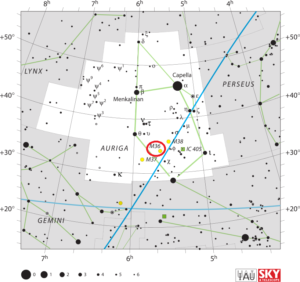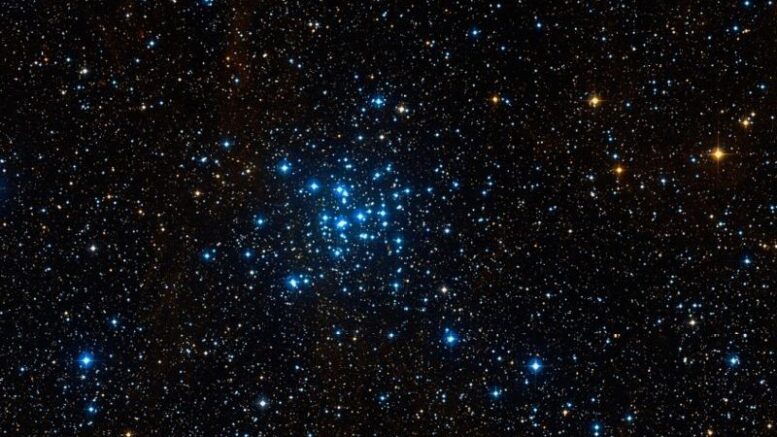Messier 36, also known as the Pinwheel Cluster, is an open cluster located in the northern constellation Auriga, the Charioteer. Messier 36 is one of the most distant open clusters catalogued by Messier and about 10 times as far away as the Pleiades.
| Description | |
| Visible From Pacific Northwest | Late October To Early March |
| Best Time To Observe | December and January |
| Minimum Size Of Viewing Device | Binoculars |
| Object Type | Open Cluster |
| Designations | Messier 36, M36, NGC 1960, Collinder 71, C 0532+341, OCISM 103, OCl 445, MWSC 0594 |
| Right Ascension | 5h 36m 12s |
| Declination | +34°08’04” |
| Constellation | Auriga |
| Age | 25,000,000 years |
| Apparent magnitude | 6.3 |
| Apparent dimensions | 12′ |
| Object Radius | 14 light years |
| Distance From Earth | 4,100 light years |
History
The cluster was discovered by the Italian astronomer Giovanni Battista Hodierna before 1654. Guillaume Le Gentil found M36 and M38 independently in 1749.
Charles Messier catalogued the cluster on September 2, 1764.
William Herschel observed the cluster with a 7-foot reflector in October 1794 and described it as a “pretty rich cluster of small stars“ that “seems to have many more than are visible, very small.” His son John Herschel catalogued M36 as h 358 and described it as a “coarse straggling cluster which fills the field; a very pretty object; the place is that of a bright star in the middle.”
John Herschel later included the cluster in the General Catalogue as GC 116, describing it as a “cluster; bright; very large; very rich; little compressed; stars from 9th to 11th magnitude scattered.”
Locating M36 In The Sky
The Pinwheel Cluster can be found by following a line drawn from Elnath in Taurus to Menkalinan in Auriga constellation. Auriga, the celestial Charioteer, is easy to find because its brightest stars form a pentagon just above Orion, to the northwest of Gemini and northeast of Taurus and the Pleiades cluster. Elnath, the second brightest star in Taurus, appears on the narrow end of the pentagon asterism. Menkalinan is located 7.5 degrees east of Capella, the third brightest star in the northern celestial hemisphere.

Viewing M36
Messier 36 is one of the fainter open clusters in Messier’s catalogue, but it can easily be seen in binoculars and small telescopes. Binoculars will show a faint, fuzzy patch of light and small telescopes at low or medium powers will reveal just over a dozen brightest stars in the cluster, arranged in an X-type shape. 6-inch telescopes will resolve about 25 stars, while 12-inch instruments will reveal stars across the cluster. The best time of year to observe M36 is during the winter months, when Auriga constellation is prominent in the night sky.
Photographing M36
Photographing the Pinwheel Cluster in some aspects will be similar to other open cluster objects as the autoguiding will need to spot on for the image to be perfectly clear. One can utilize a DSLR to take the image, but make sure to utilize a larger telescope.
Sources And Further Reading
Descriptions of all of Messier Objects can be found here.
https://www.messier.seds.org/m/m036.html
https://freestarcharts.com/messier-36
https://www.galactic-hunter.com/post/m36-the-pinwheel-cluster
https://www.cloudynights.com/topic/531783-open-cluster-messier-36-sw80ed-and-canon-400d/

Be the first to comment on "Messier 36 Pinwheel Cluster"